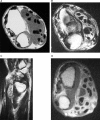Tenosynovitis with rice body formation in a non-tuberculosis patient: a case report
- PMID: 19736610
- PMCID: PMC2852770
- DOI: 10.1080/03009730902931408
Tenosynovitis with rice body formation in a non-tuberculosis patient: a case report
Abstract
In this report, we present a 68-year-old man with rice body formation in the flexor tendon sheath of the fingers without any inflammatory diseases such as tuberculosis or rheumatoid arthritis. The patient visited our institute in March 2004 with a one-month history of swelling and pain of the right distal forearm. Laboratory data were within normal limits, and the rheumatoid factor was negative. He had no history of tuberculosis, and the tuberculin reaction was weakly positive. Magnetic resonance (MR) images showed a mass measuring 6 cm x 4 cm around the flexor tendons of the forearm. Many rice bodies had been erupted from a small hole of the fibrous wall of the mass at the time of incisional biopsy performed in June 2004. Histological diagnosis was synovitis with fibrous loose bodies. In July 2004, spontaneous ruptures of the right fourth and fifth flexor tendons occurred. Open repair was performed in August 2004. The patient regained good function of the operated fingers with no evidence of recurrence at the latest follow-up in March 2009.
Figures






References
-
- Berg E, Wainwright R, Barton B, Puchtler H, McDonald T. On the nature of rheumatoid rice bodies: an immunological, histochemical, and electron microscope study. Arthritis Rheum. 1977;20:1343–9. - PubMed
-
- Pimm LH, Waugh W. Tuberculous tenosynovitis. J Bone Joint Surg. 1957;39B:91–101. - PubMed
-
- Muirhead DE, Johnson EH, Luis C. A light and ultrastructural study of rice bodies recovered from a case of date thorn-induced extra-articular synovitis. Ultrastruct Pathol. 1998;22:341–7. - PubMed
-
- Sugano H, Nagao T, Tajima Y, Ishida Y, Nagao K, Ohno T, et al. Variation among giant rice bodies: report of four cases and their clinicopathological features. Skeletal Radiol. 2000;29:525–9. - PubMed
-
- Cheung HS, Ryan LM, Kozin F, McCarthy DJ. Synovial origins of rice bodies in joint fluid. Arthritis Rheum. 1980;23:72–6. - PubMed
Publication types
MeSH terms
Substances
LinkOut - more resources
Full Text Sources
